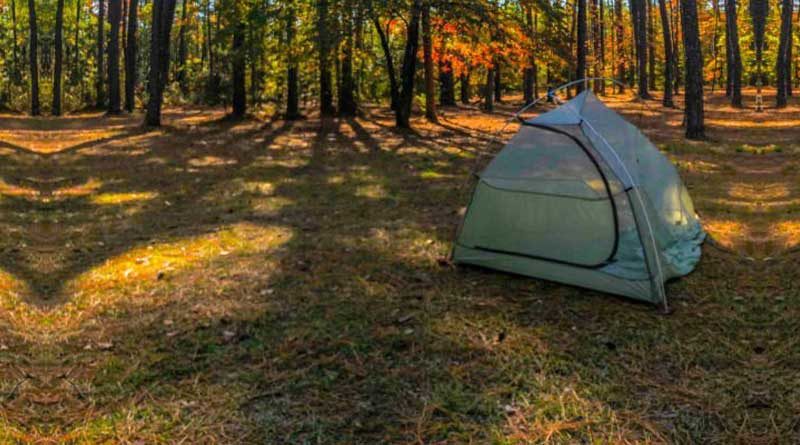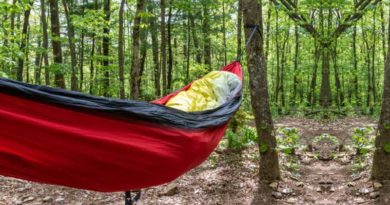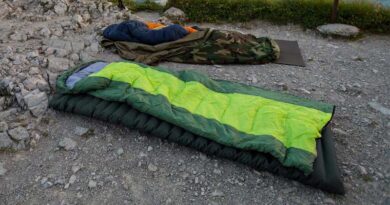Big Agnes Fly Creek vs. Copper Spur Tent
Big Agnes has some great ultralight tents. It shouldn’t be a surprise if you have settled for Big Agnes and are now confused between the Fly Creek and the Copper Spur. Both of these 3-season offerings by Big Agnes are excellent and popular and have only minor differences in performance with a moderate price difference. Keep reading for a detailed comparison of the two tents.
Big Agnes Fly Creek UL2
Weight: 2 lbs. 4 oz.
Floor Area: 28 sq. ft.
Packed Size: 19.5 x 6 in.
Peak Height: 42 in.
The Big Agnes Fly Creek is a lightweight, reasonably priced tent that is a decent performer. Its low weight is comparable to a bivy sack or a hammock. The Fly Creek has recently been updated with solution-dyed fabric, a better clip system, and a larger entry. The detailed features of Fly Creek are as follows:
Capacity
Interior capacity is one of the biggest compromises of Fly Creek. The tent has a standard floor space of 28 sq. ft. But the tapered shape of the tent won’t allow you to fit two regular size sleeping pads. The tapering at the foot also makes it extremely difficult to sleep head-to-toe with another person.
The sidewalls of the tent tend to be saggy. Big Agnes tries to counter the saggy-ness by attaching them to the guy points of the outer fly. But the walls still sag a bit giving an impression of reduced interior space. The floor of the tent is also lifted off the ground making the interior space smaller.
However, you get a good headroom of 42-inches due to the hubbed poles above the door and steeper walls. The tent also has only one vestibule and a single door opening compromising storage space and practicality. The 2-person version of the Fly Creek is better for solo use. It would feel cramped with another person.
Weight and pack size
Having a lighter weight design is a strength of the Fly Creek. The whole tent, including everything that comes with it, weighs only 2lbs 4oz. It is easier to carry around. The thin materials of the tent allow it to pack down very small making it easy to store in a backpack.
Setting up and taking down
The Fly Creek is sort of a semi-freestanding tent. It has only one hubbed pole which makes the setup process a bit simple. You just have to insert the three-pole ends into two grommets at the head and the foot and guy out two corners at the foot end.
But that is the bare minimum to set up the tent. You would have to guy out the tents at other points as well to maximize ventilation and weather protection and prevent the walls from sagging inwards. But the Fly Creek is still easier to set up and take down with its semi-freestanding design.
Performance
The Fly Creek is listed as a 3-season backpacking tent which is sort of an overstatement. It is more suitable for mild conditions. While you do get a complete rainfly and quality seam sealing, the Fly Creek still struggles in heavy rain.
The problem with the structure of the tent is having only a single-pole running down the spine. The pole doesn’t provide enough support for the tent to withstand heavy rain and stormy winds. Not only do the walls sag in, but the rainfly also presses against the sides of the walls because of no structural support. The rainfly pressing against the walls causes the water to seep through the mesh walls.
You would have to fully guy out the tent to get over this problem. The bathtub floor only comes up a few inches which may result in splashback getting in the tent during heavy rain. Having no structural support the walls of the tent also flap a lot during heavy winds making a lot of noise. You would also feel insecure in the tent because of the walls flapping too much.
The double-wall structure and generous use of mesh in the walls provide Fly Creek with excellent ventilation capabilities. Having good ventilation prevents moisture buildup in the tent. Again, you would fully guy out the tent to prevent the walls from sagging in to get full ventilation.
To stay lightweight, the Fly Creek also compromises significantly on durability. The DAC featherlight poles aren’t strong enough. It has a 20D floor that certainly requires care and the walls are very thin. So it is average in the durability department.
The Big Agnes customer service repairs rather than replace the damaged parts. Repairing may be a good thing from a sustainability point of view, something an environmentalist would cherish, but maybe a turnoff for many people.
Verdict
The Big Agnes Fly Creek is a proven ultralight design at a reasonable price. It is a decent performer in all the other metrics except weight. It would perform great in mild weather. Its double-wall design is hard to come by in the ultralight market.
While it is easier and simpler to set up, the lack of structural support limits its performance during different weather conditions. Having only a single door and vestibule also limits the practicality of the tent. But for ultralight backpackers looking to camp in the spring, summer, and fall, this is a decent performer at a reasonable price.
What I like: Very lightweight, comes with pre-attached guylines, easy to set up and takedown
What I don’t: Delicate materials, not very stable in high winds, small interior space
Big Agnes Copper Spur UL2
Weight: 3 lbs. 2 oz.
Floor Area: 29 sq. ft.
Packed Size: 19.5 x 6 in.
Peak Height: 40 in.
The Copper Spur was first introduced in 2008 by Big Agnes and it was an instant hit. It is an all-rounder with almost all the features you would want in a tent. It is a solid performer and one of the best ultralight tents you can get right now. The tent has been updated slightly to make certain improvements. The details of the features of this tent are as follows:
Capacity
The Copper Spur has a floor space only one inch larger than the Fly Creek, that is, 29 sq. ft. compared to the 28 of the Fly Creek. The Copper Spur is pretty roomy inside giving an open feeling. The interior space of this freestanding tent is further boosted by the pre-bent poles at each corner. The pole design maximizes interior space.
The interior is almost rectangular with its almost vertical walls. It has a height of 42-inches which allows two people to sit up straight. The height does drop towards the foot end but it still provides ample space.
The tapering of the tent width at the foot end is aggressive which restricts you to sleep with your head at one end. If you are sharing the tent, it is better to use mummy-shaped sleeping pads for maximum room.
The tent has two 9 sq. ft. vestibules which provide decent storage space for gear. There are two overhead pockets and two side pockets inside the tent large enough to store essentials and nighttime snacks. The overall space and the open feel of the Copper Spur are outstanding. The good thing about the tent is that it has two separate doors both having their own zippers, so you don’t have a difficult time with the doors and the zippers.
Weight and pack size
The full packages weight of the Copper Spur is 3lbs 2oz. While it is not an ultralight tent, it is still pretty lightweight for what it offers. It is a completely freestanding tent with a lot of interior space. The competitors, although lighter, compromise big time on interior space and some are only semi-freestanding. Even then the Copper Spur packs down competitively small and you will have no issues storing it in your backpack.
Setting up and taking down
The setup design of the Copper Spur is really quick and logical. Just stake out the corners and insert the poles into the color-coordinated grommets on either end and clip them in. You can only insert the poles in one way due to the asymmetrical design.
The fly goes on top and buckles easily at each corner. The fly also has Velcro attachments for the poles and guy lines. The whole process of setting up and taking down the tent doesn’t take longer than a few minutes.
Performance
The Copper Spur is a great 3-season tent that can withstand most weather conditions except heavy snowfall. The freestanding structure of the tent is sturdy in rough weather. The full-coverage rainfly does a great job of protecting from the rain. The fly of the tent also sits low on the ground preventing splashing water from entering the tent. The bathtub floor also has a good height from the ground providing further protection from splashing water.
There is generous use of mesh on the walls of the tent and a large vent at the top of the rainfly provides excellent ventilation. The Copper Spur has a double-wall structure that keeps the wind moving which helps with ventilation and prevents condensation buildup. There is good spacing between the body and the fly which allows good airflow. If you have enough ground space, the vestibules can be set up in a way that maximizes ventilation.
The Copper Spur uses not-so-strong 20D and 15D fabrics in its construction. With weight savings, durability is a cost. The mesh of the walls is 15D while the floor, rainfly, and solid portion of the fabric use a mix of 15 and 20D nylon. The nylon fabric is Big Agnes’s proprietary fabric having 20D panels that add tear strength. The fabric and the poles all feel premium and reliable.
Verdict
The Copper Spur is a lightweight option for the features it provides. Although it is not as lightweight as the Fly Creek, the jump in features is significant and the weight is still not bad. The Copper Spur is a highly practical tent which is why it has been popular from the beginning. But it is an expensive product for an ultralight tent.
What I like: Two large doors, good interior space to weight ratio, small pack size for the weight
What I don’t: Expensive and heavier than the Fly Creek
Comparison Summary
| FEATURE | FLY CREEK | COPPER SPUR |
|---|---|---|
| Trail Weight | 1 lb. 15 oz. | 2 lbs. 11 oz. |
| Packed Weight | 2 lbs. 4 oz. | 3 lbs. 2 oz. |
| Fast Fly Weight | 1 lb. 9 oz. | 2 lbs. 2 oz. |
| Packed Size | 19.5 x 6 in. | 19.5 x 6 in. |
| Floor Area | 28 sq. ft. | 29 sq. ft. |
| Head Height | 42 in. | 40 in. |
| Vestibule Area | 8 sq. ft. | 2 x (9 sq. ft.) |
| Footprint Weight | 5 oz. | 5 oz. |
| Number of Doors | 1 | 2 |
| Design Type | Semi-freestanding | Freestanding |
Which one is right for you?
Both of these tents are popular options so it all comes down to price, weight, and interior space. Copper Spur costs a bit more than Fly Creek. But there is a noticeable difference between the performance of the two, Of course, you get what you pay for.
That being said, it doesn’t mean that the Fly Creek is a bad tent by any means. It’s just that doesn’t have as many features as the Copper Spur. If you are looking for a budget ultralight tent with decent performance that will get the job done in a good way, then the Fly Creek is a good option.
The Fly Creek is also a good option if you want to pack ultralight and you are camping solo. With a partner, this tent gets cramped. However, it wouldn’t be a problem for couples, that is if they don’t end up fighting.
But if you frequently share your tent and want all-around great performance throughout the year, then it is better to invest a bit more in the Copper Spur. It has a lot of interior space and provides excellent protection in most weather conditions due to better structural support.






